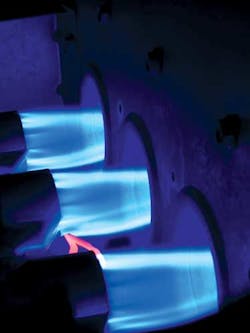Shales’ production also boosted domestic chemicals, says Kevin Swift, chief economist for Washington, D.C.-based American Chemistry Council (ACC, www.americanchemistry.com): “The [current] surge in oil prices has helped competiveness in the U.S. because overseas competitors use crude for naptha, whereas here in the U.S. feedstock is natural gas.” He cites Central Appalachia’s Marcellus Shale Play formation as contributing to the current favorable situation. “After Hurricane Katrina, natural gas cost $10 per million BTU (British thermal unit). Now, natural gas is about $4 per million BTU.”
In recent years, the intersection of three factors created the economic viability of shale gas, according to the Department of Energy’s Office of Fossil Energy and National Energy Technology Laboratory. Those include advances in horizontal drilling, advances in hydraulic fracturing (also called hydro-fracking or fracking), and rapid increases in natural gas prices.
Reliability also makes natural gas an attractive energy source. “Eighty-four percent of the natural gas consumed in the U.S. is produced in the U.S., and 97 percent of the gas used in this country is produced in North America,” explains the Department of Energy. “Thus, the supply of natural gas is not dependent on unstable foreign countries and the delivery system is less subject to interruption.”
Presently, 11 major shale-gas plays—formations containing significant volumes of natural gas and having similar geologic and geographic properties—exist under the continental U.S. “Estimates from multiple sources suggest a vast resource of technically recoverable shale gas,” remarks Rayola Dougher, a senior economist with Washington, D.C.-based American Petroleum Institute (API, www.api.org). For example, in March 2011, EIA estimated 827 trillion cubic feet (Tcf) of potentially recoverable natural gas.
Forecasts change, though. “Over the past decade, as more shale formations have gone into commercial production, the estimate of technically and economically recoverable shale gas resources has skyrocketed,” notes EIA in its recently published Annual Energy Outlook 2011. Further, “many shale formations (particularly, the Marcellus Shale) are so large that only a portion of the formation has been extensively production tested,” EIA states, adding technical advances could lead to more productive and less-costly well drilling and completion.
Gigantic promise
The Marcellus holds gigantic promise. Extending over approximately 95,000 square miles and six states, the formation contains 1,500 Tcf of natural gas and potentially could produce 3,000 cf per day per well, according to EIA. “Fully developed, the Marcellus Shale has the potential to be the second largest natural gas field in the world . . . Converted to British thermal units, the natural gas found in the Marcellus could be equivalent to the energy content of 87 billion barrels of oil, enough to meet the demand of the entire world for nearly three years,” said Timothy J. Considine, Robert Watson and Seth Blumsack, professors at The Pennsylvania State University, in a 2010 assessment.
Predictably, though, problems accompany promise. “The use of hydraulic fracturing in conjunction with horizontal drilling has opened up resources in low permeability formations that would not be commercially viable without the technology,” the ACC explains. “Public concern, however, has been raised regarding the extensive use of hydraulic fracturing because of the large volumes of water required, the chemicals added to fracturing fluids, and the disposal of these fluids after a well has been completed.” This concern manifests itself as bromide in western Pennsylvania rivers. That’s led the Commonwealth to ask drillers to voluntarily cease disposal, beginning in late May, of drilling waters at more than a dozen municipal wastewater treatment plants.
Two other states overlying the Marcellus also buzz with shale-gas activity. In West Virginia, the Marcellus found its way into May’s special-gubernatorial-election primaries. There’s also news of chemical companies committing to produce and/or purchase liquid ethane, a byproduct of natural-gas processing. In New York, where the State Comptroller’s Office has invested approximately $1 billion in natural-gas and hydro-fracking companies, the state ban on horizontal hydro-fracking ends July 1, 2011.
Some other overall concerns exist. One raised is potential contamination of underground drinking-water aquifers. Another regards gathering, transport and processing because, for example, the Marcellus’ and some other shales’ deposits don’t lie within traditional natural-gas-supply infrastructures.
Through all this, however, Dougher sees good news. “It’s the potential that new technologies [such as horizontal drilling] have enabled us to go places that we could never before. And there’s shale gas all over the nation. It’s changing the way we look at our country.”
C. Kenna Amos, [email protected], is an Automation World Contributing Editor.
Energy Information Administration (EIA, www.eia.doe.gov)
American Chemistry Council (ACC, www.americanchemistry.com)
American Petroleum Institute (API, www.api.org)
Subscribe to Automation World's RSS Feeds for Columns & DepartmentsAbout the Author
C. Kenna Amos
Contributing Editor

Leaders relevant to this article:
